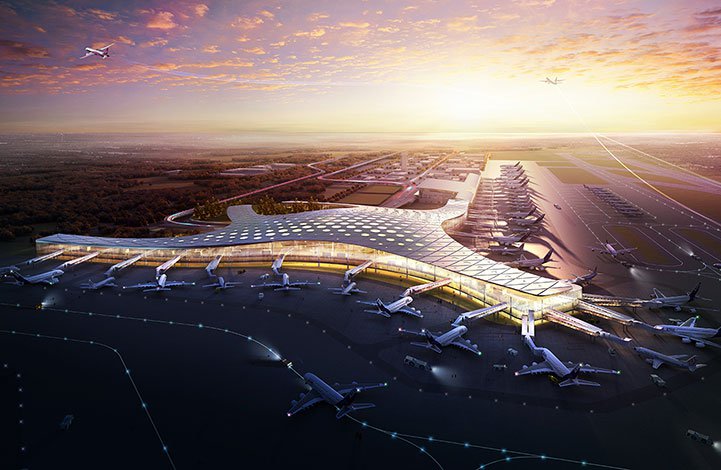
Aviation expert and principal at Hassell design studio Mark Wolfe talks with Nick Walton about terminal design, changing the traveller’s experience, sustainability, and the airports of the future.
What drew you to airport terminal design?
My first experience was while working for a small architectural practice during my university summer break; we worked on a 50-year master plan for Birmingham Airport in the United Kingdom. During that period I quickly became hooked. I think what fascinated me was the complexity of terminals as a building type – I like problem solving.
What are the best and worst airports in Asia from a design perspective?
I’m a positive kind of person so I’ll just dwell on the best. I definitely think there is a correlation between airports that are well thought out and those that consistently top traveller polls for ‘best airports’. Changi mostly gets things right; certainly from an experience and product point of view. The design is internally focused with the building architecture being secondary and relatively modest. This suggests that they understand how people experience terminals. From an architecture and planning perspective, Hong Kong Terminal 1 was the next iteration after Stansted Airport in the UK (one of my hero airports). You can see the DNA of Stansted in places and things that have been improved upon.
What’s missing from today’s airports and how can we make them more endearing spaces for travellers?
Probably what is lacking is choice. It’s evident that people’s needs and expectations are changing as they exert more control over their journey; they want different things than they did even 5-10 years ago. Airport retail is still a key revenue stream but recent figures suggest it is in decline relative to F&B. Passengers are now looking for alternatives to shopping; they’re looking for things to do or experience. That could be a stimulating experience in a bustling, vibrant retail and dining zone or a relaxed experience in a rest area, library or gallery.
Size and scale can also be an issue. Larger terminals can feel uncomfortable and intimidating, so we need to think of introducing intimate, human scale spaces. As the traveller demographic changes we need to further explore how we accommodate an ageing population, their needs, and services we need to offer them.
Finally, I think the industry can still do more to cater for families – a play area isn’t the only solution!
How much does design actually affect the traveller’s experience at an airport?
Design affects the traveller’s experience completely. Bad design can result in poor way finding, lengthy queues at security, accessibility issues for the elderly and so on. Conversely, good design can improve on these things. Feeling at ease, experiencing natural light or a view, enjoyment and engagement with the building and the activities on offer can all be achieved with good design. Our design philosophy concentrates on context, function, aspiration and beauty.
You’re a member of an international panel reviewing standout airport projects globally – what are some of the success cases and where does Asia stand in the rankings?
If you look at the Skytrax awards for 2016, 4 out the 5 top ranked international airports are located in Asia so I would say Asia is doing very well. Look out for the next major projects at Hong Kong (Third Runway Concourse) and Changi (T4 and T5). I expect these will demonstrate a step change in terminal design, product and experience. Better, faster and with greater amenity.
You’re a believer in ‘maximizing value’ in modern airports; does that mean turning them into malls with airplanes?
That’s a simplistic way of looking at value – yes, maximizing commercial value of retail is important but there are other categories of value that we explore too; cultural, environmental and brand for instance. What we mean by ‘maximising value’ is that we strive to extract every possible opportunity from a project ensuring that our clients and their customer and stakeholders get the best possible outcome.
How responsive are governments and airport authorities to innovations in design?
It’s mixed and depends on the individual circumstances of the airport. Many really appreciate and understand the value of good design and what it can achieve; some don’t focus so heavily on pushing innovation. Some have a view that good design costs a lot of money but many have found that investing in great design from the outset actually saves money both through the design process and through operations.

What kinds of services and amenities are missing from many airports?
I think there is room for more diversity and I also think more could be done to deal with different passenger groups appropriately at key processing points such as security or immigration. I’m thinking assistance lanes, family lanes and other segments needing specialised services. As technology becomes more embedded and takes over from people doing the standard check-in processes I think staff will be re-assigned to customer service/hosting roles, creating the opportunity to give these groups and others a more personal level of assistance.
How can airports benefit from urban design and city planning?
I’ve been talking at airport real estate conferences recently about how airport precincts can be designed to be more attractive to high value commercial tenants. The premise is that if you utilise the same key urban design tools that we use when planning cities you will stand a better chance of creating a meaningful ‘place’ to which potential tenants can attract talent. That place needs to be well connected and diverse in what it offers.
The aviation industry is often a target for its carbon footprint; how important are sustainability aspects for airport design?
With terminal building design there are multiple opportunities to investigate innovative sustainable solutions. For example, daylighting (reduced reliance on artificial light), photovoltaics, grey water recycling, and tri generation to name just a few. Unfortunately, here in Australia, there is a high reliance on car travel and subsequently parking is a major revenue source for airports. It is also a source of pollution. Better and more diverse public transport options are a great means of reducing pollution and also make sense for airports wanting to ensure passengers have greater choice and control of a stress free journey from their home, to and through the airport and onto the plane.





